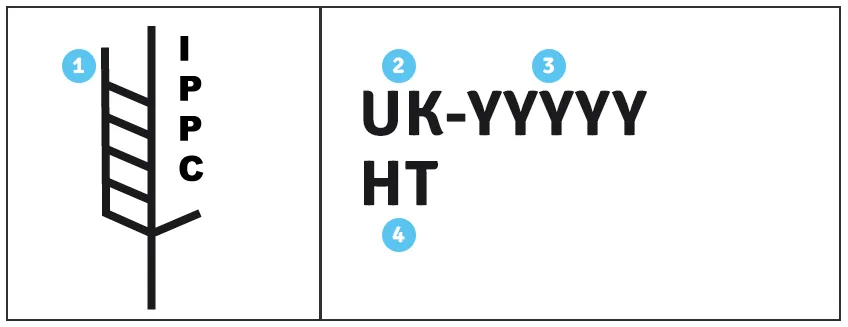
In international trade, wooden containers and pallets are indispensable due to their robustness and stability for safely transporting exports over long distances. To ensure that these timber packaging materials meet high standards, they must fulfill specific quality criteria. There are regulations such as the ISPM 15 standard for wood packaging materials. Developed by the International Plant Protection Convention (IPPC), this standard ensures that wood packaging materials are free from pests and do not pose a risk to the environment.
In this article, you will learn everything important about the ISPM 15 standard: its significance in international trade, which companies and wood packaging materials are affected, the different treatment methods, the necessary markings for compliant packaging, which countries require certification according to ISPM 15, and the essential obligations for import and export.
What is ISPM 15? The ISPM 15 standard, officially known as the “International Standard for Phytosanitary Measures for Wood Packaging Material in International Trade,” is a phytosanitary standard developed under the International Plant Protection Convention (IPPC) of the Food and Agriculture Organization of the United Nations (FAO). Its main objective is to prevent the introduction and spread of wood pests through wood packaging material, thereby protecting natural ecosystems worldwide.
Companies manufacturing wood packaging for international trade must ensure that their packaging materials meet specific phytosanitary standards according to ISPM 15. This includes various treatment methods such as heat treatment or fumigation, which are intended to ensure that the wood is free from pests. A standardized marking confirming successful treatment according to ISPM 15 is required to demonstrate compliance with regulations during international shipping.
ISPM 15: International Standards for Phytosanitary Measures No. 15 An international standard prescribing specific requirements for the treatment of wood packaging material to prevent the spread of pests.
IPPC: International Plant Protection Convention An intergovernmental agreement to coordinate global measures to protect plants from pests and diseases.
FAO: Food and Agriculture Organization A specialized agency of the United Nations dealing with food, agriculture, and rural development.
Any company that first introduces wood packaging within the EU is affected, including market participants such as importers and traders dealing commercially with wood packaging and pallets already within the EU. The shipper must ensure that the imported or exported packaging complies with the ISPM 15 standard, as customs authorities may reject the goods if the corresponding marking is missing.
The ISPM 15 directive concerns all wood packaging material that could potentially serve as a pathway for pests and thus pose a danger, especially to living trees. This includes solid wood packaging material or components thereof, such as:
These exemptions may vary depending on the country and specific laws, so it is important to consult national regulations to ensure compliance with all requirements.
The ISPM 15 standard specifies various methods to ensure that wood packaging is free from pests and does not pose a risk to global ecosystems. Recognized methods include:
These methods ensure that wood packaging meets ISPM 15 requirements and can be used safely in international trade. It is important to observe the specific regulations and restrictions in each country to ensure compliance with international standards.

The ISPM 15 marking on wood packaging indicates that the wood has been treated according to the guidelines to combat pests and prevent the spread of diseases. The marking follows a standardized format and must be clearly visible on the packaging. Companies wishing to mark wood packaging must register with the relevant plant protection service and undergo annual checks to ensure compliance with ISPM 15 requirements.
According to regulations, the ISPM 15 marking must be framed, clearly visible on each package, and preferably permanently and inseparably attached to the wood on two opposing sides. It must not be removable without damage and should ideally be applied with a branding stamp, ink stamp, or stencil. The size of the marking must be appropriate to the packaging size, avoiding the use of red and orange colors, as these are reserved for hazardous materials labeling.
The ISPM 15 marking ensures that only appropriately treated wood packaging can be used in international trade without the need for additional treatment certificates or phytosanitary certificates. Compliance with this marking requirement is essential in many countries, as missing markings can lead to re-treatment or even rejection of the shipment.

Within the EU
For wood packaging materials used within the European Union or in trade with Switzerland, ISPM 15 treatment or certification is generally not required – except for certain areas in Portugal and Spain due to the presence of the pinewood nematode. Packaging originating from these regions and exported to other EU countries or to third countries must be treated and marked according to ISPM 15.
In addition, the European Union applies specific regulations for the import of wood packaging from non-EU countries.
Under Regulation (EU) 2019/2125 and Implementing Regulation (EU) 2024/288, wood packaging accompanying imported goods is systematically or risk-based inspected to prevent the introduction of harmful organisms.
The implementation of these controls varies among Member States: some countries – particularly in Eastern and Southern Europe – perform checks on nearly all consignments containing wood packaging, even without explicit national legislation.
Recommendation: Always use ISPM 15-compliant materials and maintain proper documentation to avoid delays or rejections during EU import inspections.
America (USA), Canada, and Mexico
The NAPPO countries (USA, Canada, and Mexico) introduced the ISPM 15 standard starting September 16, 2005, fully enforced from July 5, 2006. In the USA, phytosanitary regulations were adjusted. Canada specified requirements in D-98-08, and Mexico implemented the standard from November 27, 2003. Non-compliant packaging is directed for re-export, and all costs incurred are borne by the importer.
China
Since January 1, 2006, wood packaging must be treated and marked according to the ISPM 15 standard. A phytosanitary certificate is no longer required. Packaging from areas with pine wood nematodes must undergo heat treatment. The packaging must be bark-free and display the IPPC/FAO mark on two sides. Engineered wood products such as plywood and MDF are exempt.
Australia
Australia introduced the ISPM 15 standard from September 1, 2004. All wood packaging must be treated and marked. It must be made from debarked wood and may undergo further checks upon arrival. Additional information and requirements can be found on the AQIS website. Australia also recognizes alternative treatments approved by AQIS.
In Other Countries
Over 120 WTO member states have signed the FAO ISPM 15:2009 document, but not all have implemented it into national regulations. A complete list of countries applying the ISPM 15 standard can be found here >>
In summary, the ISPM 15 standard for wood packaging materials is essential for international trade, ensuring that wood packaging is free from pests and does not pose a risk to global ecosystems. Compliance with ISPM 15 regulations requires treating wood packaging materials according to recognized methods and marking them accordingly. Companies involved in the manufacture and export of wood packaging must be aware of and comply with these regulations to avoid delays, additional costs, or rejection of shipments in international trade.
Additional sources:
Source 1: ISPM 15 Stamp
Source 2: ISPM 15 Treatment Methods
Source 3: ISPM 15 Country List
Source 4: Official Explanatory document for ISPM 15 by Food and Agriculture Organization
Source 5: Guidelines for regulating wood packaging material in international trade by IPPC





